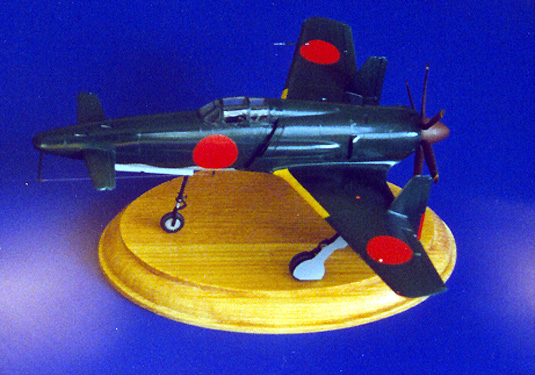
Hasegawa 1/48 Kyushu J7W Shinden
Price: $20-25 US
Review and Photos By: John Lester onezero@aol.com

THE AIRCRAFT
As WWII ground on, Japan's need for a high-performance fighter/interceptor became so acute that the authorities considered some highly unusual designs. One of the most promising was the J7W Shinden ("Magnificent Thunderbolt"), the only canard type aircraft to be ordered for mass production during the war. The brainchild of Captain Masaoki Tsuruno, a Navy technical officer, who first sketched out the design in 1943. The Navy technical organization took an interest in the project, and by late 1943 three glider prototypes were being used to test the concept. Results were good enough that Kyushu Hikoki K.K. was commissioned to build a fighter/interceptor based on these findings.
In just ten months a prototype was built. The aircraft had the same basic layout as the gliders, but with engine, tricycle landing gear and armament. The 2130 hp Mitsubishi MK9D radial engine was completely enclosed in the middle fuselage, and drove a 6-bladed propeller by means of a transmission shaft. Four 30mm cannon provided a heavy punch.
The Navy ordered the aircraft into mass production even before the J7W had been flight tested. Both Nakajima and Kyushu began organizing production lines that would turn out 150 fighters a month. Unfortunately (or not, if you look at it from the Allies' viewpoint) Japan's surrender cancelled the project. Only one of the two prototypes ever got into the air. Today, the surviving machine awaits restoration in the National Air and Space Museum in Washington.
THE KIT
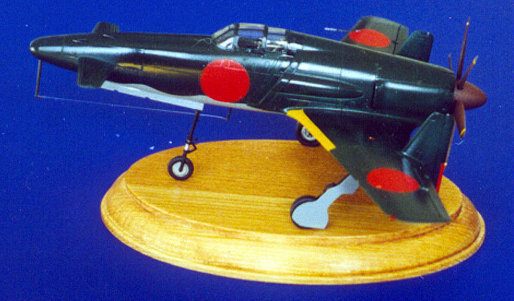
I admit it - I'm a sucker for the odd, obscure and overlooked aircraft ... which is why I snapped up this kit as soon as I saw it. Despite being Hasegawa's older offerings, and not being as nicely detailed as their later 1/72 offering, it's certainly not a bad kit. Mine was a later release and included flattened resin wheels. The basic model was state of the art as little as 5 years ago and has aged gracefully. Detail is crisp, with finely raised panel lines and engraved control surfaces. Flash was non-existent and there were few ejector pin marks and no sinkholes to mar visible surfaces. The cockpit is one of the better ones Hasegawa has done, needing only seatbelts to improve it to my satisfaction. The resin wheels are nicely done, but the kit wheels aren't bad and are certainly useable. Fit was, for the most part, pretty good throughout. Decals are provided for the first prototype aircraft (another release -"Metropolitan Defense 1946"- includes different markings for a hypothetical production version). The decals were the only real disappointment ... but more on that in a moment.
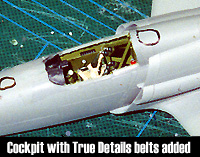 Construction
was straightforward and mostly followed the sequence outlined in the
instructions. The cockpit parts were painted and assembled following the
paint call-outs. The cockpit sidewalls and tub were painted a "bamboo green"
made by adding a few drops of grey to RAF Interior Green (all paints are
Testors Model Master, by the way, unless otherwise noted). No decal is provided
for the instrument panel, which is fine by me - I always hand paint and drybrush
mine.
Construction
was straightforward and mostly followed the sequence outlined in the
instructions. The cockpit parts were painted and assembled following the
paint call-outs. The cockpit sidewalls and tub were painted a "bamboo green"
made by adding a few drops of grey to RAF Interior Green (all paints are
Testors Model Master, by the way, unless otherwise noted). No decal is provided
for the instrument panel, which is fine by me - I always hand paint and drybrush
mine.
When the cockpit was done I glued it in place and assembled the fuselage.
I missed the note pointing out ballast is needed in the far forward part
of the nose, and as a result, my model is a tailsitter. Ah, well. Fuselage,
wings and rudders went together with minimal fuss, though I did need to spend
a fair amount of time sanding and puttying the joins to make them smooth.
The worst areas were at the tip of the nose and each wing tip -- the seam
through the tips of the ailerons was actually difficult to fix.
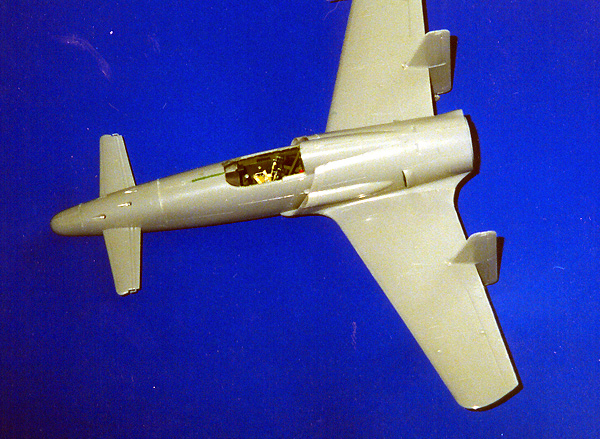 Props, gear
and gear doors were assembled and painted, but not installed until after
painting and weathering was complete. The props were painted a mix of Italian
Camouflage Brown and British Crimson to get the "mahogany" shade used by
the Japanese. Landing gear bays were painted Aluminum, then overcoated with
a thinned spray of Japanese Interior Blue Metallic to replicate the "aotake"
covering (which the NASM example still wears). Exposed wiring was drybrushed
flat black.
Props, gear
and gear doors were assembled and painted, but not installed until after
painting and weathering was complete. The props were painted a mix of Italian
Camouflage Brown and British Crimson to get the "mahogany" shade used by
the Japanese. Landing gear bays were painted Aluminum, then overcoated with
a thinned spray of Japanese Interior Blue Metallic to replicate the "aotake"
covering (which the NASM example still wears). Exposed wiring was drybrushed
flat black.
Once all that had dried I masked off all the openings with tape and tissue and primed the model with grey automotive spraypaint. I fixed all the flaws this brought to light then painted the undersides IJN Grey. When this had dried I masked the bottom off and sprayed IJN Green over the top surfaces. While the paint was drying ( I let it cure for a full day) I dipped the canopy in future floor polish, then painted the framing by hand.
Decals turned out to be a major pain and the only part of the kit that was not enjoyable. The Testors green and grey are actually quite glossy so I skipped my usual application of clear gloss before applying decals. I don't think this step would have helped anyway. The kit decals just did not behave well. The hinomarus (meatballs) refused to conform to the surfaces under them, and despite all my efforts I could not get rid of huge air bubbles under them. The various stripes and other markings either broke apart (exploded in some cases) or silvered horribly. In the end I stripped all but the rudder markings off. I dug up a set of hinomarus from the Tamiya Zero kit and used them instead - they didn't conform perfectly either, but look a thousand percent better than the Hasegawa ones. No decals are provided for the warning stripes on the props so I hand panted these as well.
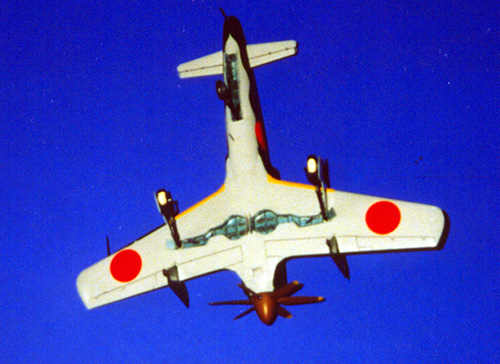
I decided to build this as a factory-fresh machine, so weathering was held to a minimum. When the decals had set as much as they were going to I flipped the model on it's back and added the landing gear and antennas. Unfortunately, I put the gear on backward (despite checking the diagrams three times before I did so!) and had to break them off. After a great deal of thought and not a few curses I reattached them by drilling out the mounting holes, then using a thin brass rod as a pin to support them. Not a perfect solution, and it took three tries to get something that didn't collapse as soon as you look at it. Finally, the model was glued to a simple pine base (so that I can handle it as needed without gear snapping off).
Despite the trouble with the decals and landing gear (my own fault, that) this was an enjoyable project. The model certainly looks sharp up on the shelf next to my Luft '46 airplanes. I recommend it to anyone including a novice.
Now if we could just get a Kikka in the same scale and price range ....
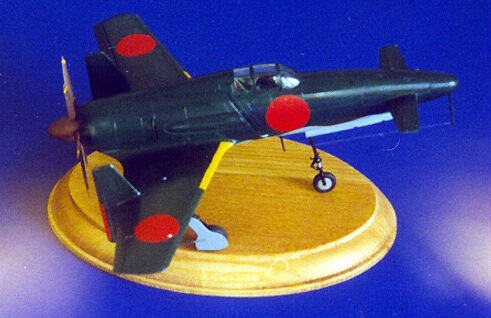
Copyright ModelingMadness.com. All rights reserved. No
reproduction in part or in whole without express permission.
Back to Reviews Page
2023